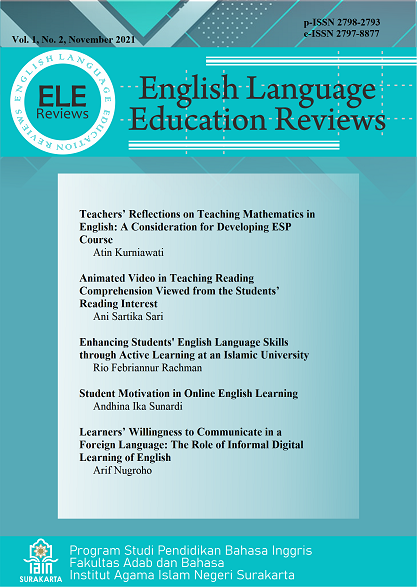Learners Willingness to Communicate in a Foreign Language: The Role of Informal Digital Learning of English
DOI:
https://doi.org/10.22515/ele-reviews.v1i2.4396Keywords:
informal learning, informal digital learning of English, willingness to communicate in English, Indonesian EFL learnersAbstract
The trend of online teaching and learning in the age of the COVID-19 pandemic has driven contemporary students to learn English in an informal context outside the classroom. Drawing on this issue, the present study is at the cutting edge of examining the role of Informal Digital Learning of English (IDLE) in affecting students willingness to communicate in a foreign language. A total of 156 (male=63; female=93) Indonesian EFL students participated in survey research upon invitation. The data are obtained by means of an online questionnaire consisting of three parts: (1) willingness to communicate, (2) IDLE, and (3) demographic data. The hierarchical regression analysis results reveal that Frequency of IDLE, Receptive IDLE activity, and Productive IDLE activity are the positive predictors of EFL learners willingness to communicate in English as a foreign language. The results indicate that the Indonesian EFL learners are motivated to communicate in English when engaging in a range of IDLE activities. In other words, it is implied that IDLE activities (both productive and receptive) potentially build the communication behavior of Indonesian EFL learners, who learn English as a foreign language and possess a culturally homogeneous society.
Downloads
References
Ghonsooly, B., Khajavy, G. H., & Asadpour, S. F. (2012). Willingness to communicate in English among Iranian non-English major university students. Journal of Language and Social Psychology, 31(2), 197-211.
Lai, C., Wang, Q., Li, X., & Hu, X. (2016). The influence of individual espoused cultural values on self-directed use of technology for language learning beyond the classroom. Computers in Human Behavior, 62, 676-688. https://doi.org/10.1016/j.chb.2016.04.039
Lai, C., & Zheng, D. (2018). Self-directed use of mobile devices for language learning beyond the classroom. ReCALL, 30(3), 299-318. https://doi.org/10.1017/S0958344017000258
Lee, J. S. (2019). Informal digital learning of English and second language vocabulary outcomes: can quantity conquer quality? British Journal of Educational Technology, 50(2), 767-778. https://doi.org/10.1111/bjet.12599
Lee, J. S. (2020). Informal digital learning of English and strategic competence for cross-cultural communication: perception of varieties of English as a mediator. ReCALL, 32(1), 47-62. https://doi.org/10.1017/S0958344019000181
Lee, J. S., & Drajati, N. A. (2019). English as an international language beyond the ELT classroom. ELT Journal, 73(4), 419-427. https://doi.org/10.1093/elt/ccz018
Lee, J. S., & Lee, K. (2021). The role of informal digital learning of English and L2 motivational self system in foreign language enjoyment. British Journal of Educational Technology, 52(1), 358-373.
Lee, J. S., & Sylvén, L. K. (2021). The role of informal digital learning of English in Korean and Swedish EFL learners’ communication behaviour. British Journal of Educational Technology, 52(3), 1279-1296. https://doi.org/10.1111/bjet.13082
Makruf, I., Putra, H.R., Choiriyah, S., & Nugroho, A. (2021). Flipped learning and communicative competence: an experimental study of English learners. International Journal of Education in Mathematics, Science and Technology, 9(4), 571-584.
Mutiaraningrum, I., & Nugroho, A. (2020). Social construction of knowledge in synchronous text-based discussion during English language learning. Journal on English as a Foreign Language, 10(2), 315-336. https://doi.org/10.23971/jefl.v10i2.1934
Naghdipour, B. (2017). ‘Close your book and open your facebook’: a case for extending classroom collaborative activities online. Journal of Asia TEFL, 14(1), 130-143. https://doi.org/10.18823/asiatefl.2017.14.1.9.130
Nugroho, A., & Atmojo, A. E. P. (2020). Digital learning of English beyond classroom: EFL learners’ perception and teaching activities. JEELS (Journal of English Education and Linguistics Studies), 7(2), 219-243.
Nugroho, A., Haghegh, M., & Triana, Y. (2021). Emergency remote teaching amidst global pandemic: voices of Indonesian EFL teachers. VELES Voices of English Language Education Society, 5(1), 66-80.
Nugroho, A., & Rahmawati, A. (2020). “Let’s write a caption!”: utilizing instagram to enhance ESP students’ writing skills. JURNAL BASIS, 7(1), 1-12.
Peng, J., & Woodrow, L. (2010). Willingness to communicate in English: a model in the Chinese EFL classroom context. Language Learning, 60(4), 834-876.
Reinders, H., & Benson, P. (2017). Language learning beyond the classroom: a research agenda. Language Teaching, 50(4), 561-578.
Şener, S. (2014). Turkish ELT students’ willingness to communicate in English. ELT Research Journal, 3(2), 91-109.
Triana, Y., & Nugroho, A. (2021). Brief ELT in digital classroom for lazy creative lecturers (option after post pandemic recovery): lecturers’ perspectives. Indonesian Journal of EFL and Linguistics, 6(1), 79-99.
Wardani, A., & Suharto, T. (2021). Optimizing the role of informal learning in the perspective of Islamic education during the Covid-19 pandemic. Journal of Educational Management and Instruction (JEMIN), 1(1), 28-39. doi:https://doi.org/10.22515/jemin.v1i1.3456
Wijaya, S. A., Asib, A., & Suparno, S. (2021). Portraying informal digital learning of English from management, beliefs, and practices. Register Journal, 14(2). https://doi.org/10.18326/rgt.v14i2.%25p
Downloads
Published
How to Cite
Issue
Section
Citation Check
License
Copyright (c) 2021 Arif Nugroho

This work is licensed under a Creative Commons Attribution-NonCommercial 4.0 International License.
Authors retain copyright and grant the journal right of first publication with the work simultaneously licensed under a Creative Commons Attribution License that allows others to share the work with an acknowledgement of the work's authorship and initial publication in this journal.
This ejournal system and its contents are licensed under
a Creative Commons Attribution-NonCommercial 4.0 International License







